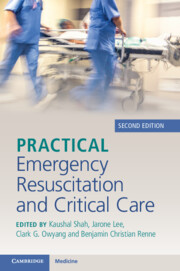Book contents
- Practical Emergency Resuscitation and Critical Care
- Practical Emergency Resuscitation and Critical Care
- Copyright page
- Contents
- Contributors
- Preface
- Section 1 General Critical Care
- Section 2 Infectious Disease Emergencies
- 5 Covid-19
- 6 Sepsis and Septic Shock
- 7 Pneumonia
- 8 Meningitis and Encephalitis
- 9 Infective Endocarditis
- 10 Necrotizing Soft Tissue Infections
- 11 Complications of Human Immunodeficiency Virus (HIV) and Acquired Immunodeficiency Syndrome (AIDS)
- Section 3 Neurological Emergencies
- Section 4 Cardiovascular Emergencies
- Section 5 Respiratory Emergencies
- Section 6 Gastrointestinal Emergencies
- Section 7 Renal Emergencies
- Section 8 Hematology–Oncology Emergencies
- Section 9 Endocrine Emergencies
- Section 10 Environmental Emergencies
- Section 11 Trauma
- Section 12 End of Life
- Index
- References
10 - Necrotizing Soft Tissue Infections
from Section 2 - Infectious Disease Emergencies
Published online by Cambridge University Press: 02 November 2023
- Practical Emergency Resuscitation and Critical Care
- Practical Emergency Resuscitation and Critical Care
- Copyright page
- Contents
- Contributors
- Preface
- Section 1 General Critical Care
- Section 2 Infectious Disease Emergencies
- 5 Covid-19
- 6 Sepsis and Septic Shock
- 7 Pneumonia
- 8 Meningitis and Encephalitis
- 9 Infective Endocarditis
- 10 Necrotizing Soft Tissue Infections
- 11 Complications of Human Immunodeficiency Virus (HIV) and Acquired Immunodeficiency Syndrome (AIDS)
- Section 3 Neurological Emergencies
- Section 4 Cardiovascular Emergencies
- Section 5 Respiratory Emergencies
- Section 6 Gastrointestinal Emergencies
- Section 7 Renal Emergencies
- Section 8 Hematology–Oncology Emergencies
- Section 9 Endocrine Emergencies
- Section 10 Environmental Emergencies
- Section 11 Trauma
- Section 12 End of Life
- Index
- References
Summary
For the clinical applications of this chapter, necrotizing soft tissue infections (NSTIs) will refer to infection of deep subcutaneous tissues and adjacent fascia.
Mortality is estimated to be around 20–50% in observational literature with variation by infection site and specific organism.
Paucity of early physical examination findings can lead to a delay in diagnosis, as classic superficial findings do not manifest until later in the disease course.
Infection leads to toxin production, cytokine activation and microthrombosis, which all contribute to ischemia, impaired antibiotic delivery and rapid progression.
Early surgical intervention decreases morbidity and mortality.
NSTIs can be classified based on microbial etiology, with polymicrobial etiology being the most common. Type I necrotizing fasciitis is polymicrobial in origin. Type II is monomicrobial, often caused by group A Streptococcus (typically, S. pyogenes). Staphylococcal NSTIs are increasing in prevalence due to community-associated methicillin-resistant S. aureus.
Exotoxin release by clostridia, staphylococci and streptococci can enhance cytokine release and promote an inflammatory cascade, which can lead to death if untreated.
NSTIs are more common in patients with comorbidities including diabetes mellitus, chronic alcoholism, chronic renal failure, HIV, liver failure (which is classically associated with Vibrio vulnificus) and other immunosuppressed states.
- Type
- Chapter
- Information
- Practical Emergency Resuscitation and Critical Care , pp. 83 - 88Publisher: Cambridge University PressPrint publication year: 2023



